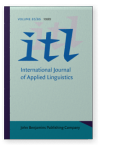Vol. 85/86 (1989) ► pp.105–121
Vol. 85/86 (1989) ► pp.105–121
The Role of Cognitive and Hemispheric Processing Styles in L2 Learning
L2 learners fall into two major categories in terms of their cognitive styles. The first group comprises the relatively analytical individuals, who are said to be predominantly field independent. The second group, on the other hand, embodies the relatively holistic persons, who are said to be chiefly field dependent. L2 learners are further classified in terms of their hemispheric processing styles. Some learners are left-hemisphere dominant while others are right-hemisphere dominant. The former are thought to be more efficient with analytic processing in which the left hemisphere specializes. By contrast, the latter are described as more efficient with holistic processing in which the right hemisphere specializes. After reviewing the available evidence for the associations between cognitive and hemispheric processing styles, the paper discusses the educational implications of L2 learners' differences with respect to cognitive and hemispheric dimensions.
